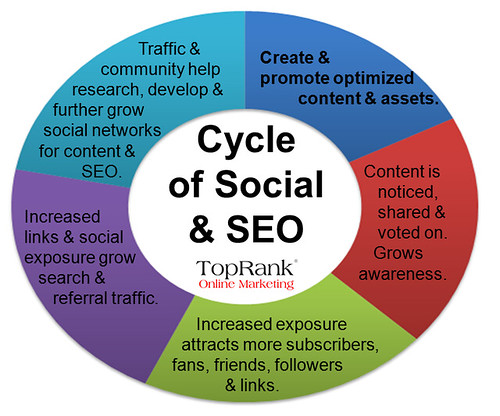 Lee Odden, TopRank Online Marketing CEO gave the opening keynote of Online Marketing Summit Minneapolis. Lee spoke on the intersection of SEO and social media and provided key takeaways for companies on achieving success.
Lee Odden, TopRank Online Marketing CEO gave the opening keynote of Online Marketing Summit Minneapolis. Lee spoke on the intersection of SEO and social media and provided key takeaways for companies on achieving success.
As the social web and search engines integrate and innovate tighter, the intersection between search and social is growing more meaningful daily. Following is a summation of this info-packed presentation:
What would happen if your Google traffic disappeared tomorrow? What impact would that have on your marketing and your business? For many, this could be disastrous. This highlights the importance of diversifying your brand’s referring sources and share of voice around the web.
Search and social are intersecting in many ways: when you look at a comparison of the top search engines, more and more of the engines themselves are on social platforms, and more of the results on the big engines are social.
Think about amplifying the results you are getting from natural SEO by amplifying your content through social channels.
Google dominates search, but should it dominate your marketing?
Lee shared some stats that help support the diversification of your traffic and digital influence:
- 90% of consumers trust peer recommendations, according to Nielsen, but only 14% trust advertisements according to Larry Weber
- Facebook added more than 200 million users in less than a year according to the Facebook timeline
- Facebook tops Google for weekly traffic in the US
- 2nd most popular search engine isn’t Yahoo, it’s YouTube according to comScore
- 80% of companies use social media for recruitment, 95% of those are LinkedIn
The stats paint a clear picture: that social is vital to integrate with search and your marketing program overall. According to SEMPO, 35% of B2B companies integrate social media and search engine marketing programs – is your brand?
HubSpot is a great social/SEO example – they receive 20,000 leads a month from inbound efforts.
What about search and social as it integrates with PR and media relations? To research stories:
- 89% of journalists use blogs
- 65% use social networks
- 52% use Twitter
Jon Gordon from NPR noted:
I use search engines on almost every story. I use social networks to find additional sources as well as for the story idea generation and story feedback.
How to leverage SEO for marketing and PR:
If you already have a keyword glossary, that can be shared with PR to leverage for their content creation to be optimized for journalists.
How do SEO and social media intersect?
Add a layer of search to your social activity: are you leveraging keywords across your social web participation? If not, you should be. Give your keyword glossaries to your social media marketing and PR team to use across marketing efforts. Cumulatively this leads to better visibility not just in Google but in social search as well.
One of the problems of social media and SEO is that they are usually put in silos within an organization. But, you can bring them together to amplify results. You can’t afford not to combine social and SEO. In fact, if you are in a competitive category, it’s difficult to compete if you aren’t engaged. As just one example, it’s difficult to acquire lots of high quality, organic links unless you can promote great content to a significant number of people.
Ecommerce is social
Target, 1-800 Flowers, and other e-commerce brands are going social. They are integrating their online purchasing with social sites in order to tap into networks along with purchasing. Companies that are doing this type of activity are training their customers to make social a part of the purchasing process.
Customer service is social
Large brands are leveraging social tools for CRM purposes and sales opportunities. All you need to do to see the opportunity is query a topic customers are seeking information on and you can be the one to respond.
Most importantly, people are social and people search. As long as there is content that can be sorted, there is an opportunity to optimize it.
Is social a threat to search? No – search isn’t going anywhere. Social sites are popular but according to both consumer data and the nature of the web they are not a threat to search.
4 keys to Social SEO:
Listening, content, socialize, measurement
Listening – understand the channels so you can make smart decisions about your tactics. Listening also provides you social keyword research to mine data from your target audience. If you have ever created a social listening report, you know it’s keyword-based and the value of understanding the language audiences use.
Content – The thing that makes social or SEO fantastic is content. If you don’t have a great message, you don’t have anything. Take stock of content assets in order to be able to maintain consistency with communications. After inventory, you can sync that up with an editorial plan. Skipping this step can lead to failure: for example, many create blogs and run out of things to say quite quickly. Without a plan, it’s easy to get stuck. Next, map your content to those social keywords developed to maximize visibility in search.
Socialize – give to get, and grow a network of relevant people. Even if you have great content, no one will know to link to it or share it unless you promote it.
Distribution channels are essential – create content around the needs of your customers and send through distribution channels that are independent of Google – for example, RSS, email, social, media/PR and contributed articles. The kicker is if done effectively, your performance in Google skyrockets.
Cycle of social and SEO:

Measure – get social monitoring tools and social analytics in place in order to understand and get feedback on your content and participation. Look at the performance of your content and your competition’s content in order to provide insight.
Marketo (a TopRank client) as an example created a social SEO strategy that focused on keywords and content their customer finds valuable as opposed to limiting themselves purely to keywords describing the product.
3 things you can do now:
1) Establish a listening program
2) Implement a content marketing strategy
3) Leverage social media marketing campaign management tools (which will be explored in a future post at TopRank Blog).
Be sure to check out the OMS video interview (in a phone booth!) with Lee, Rick Burnes from HubSpot, Joe Pulizzi from Junta 42 and Aaron Kahlow of Online Marketing Summit. We cover what tactics marketers should put a hold on, which big brands are not to be trusted (Twitter, Facebook, Microsoft or Google). Guess which brand no one voted for? And the best thing about OMS. Click the image below to see the video.



